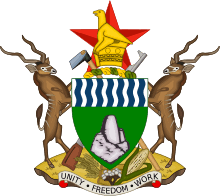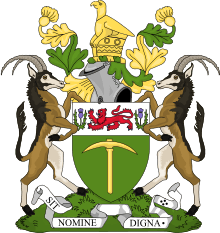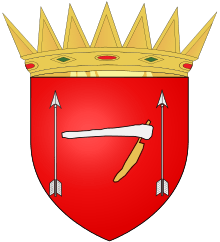Coat of arms of Zimbabwe
| Coat of arms of Zimbabwe | |
|---|---|
 | |
| Details | |
| Armiger | Republic of Zimbabwe |
| Adopted | 1981 |
| Crest | A mullet of five points Gules charged with the Great Zimbabwe Bird Or |
| Torse | A wreath Or and Vert |
| Escutcheon | Vert, the ruins of Great Zimbabwe, Argent and a chief paly wavy of 15 pieces Argent and Azure |
| Supporters | Two Kudus (Tragelaphus strepsiceros bovidae) proper |
| Compartment | The african soil charged with a cotton flower between a sheaf of wheat and a maize-cob proper |
| Motto | UNITY, FREEDOM, WORK |
| Other elements | In behind the shield, an adze and a rifle in saltire |
The current coat of arms of Zimbabwe was adopted on September 21, 1981, one year and five months after the national flag was adopted. Previously the coat of arms of Zimbabwe was identical to the former Coat of arms of Rhodesia.
Description
The coat of arms depicts two Kudus on the left and right, each standing on top of an earthly mound composed of stalks of wheat, a pile of cotton, and a head of maize. At their feet there is also a banner emblazoned with the Zimbabwean national motto (Unity, Freedom, Work). The shield itself is green, featuring 14 waves of alternating white and blue waved lines at top (chief argent), and also at the centre of the shield a representation of the ancient Kingdom of Great Zimbabwe is shown. Placed behind the shield are an agricultural hoe (to the left) and an AK-47 assault rifle (to the right).[1] The wreath is gold and green and the crest features the Zimbabwe Bird on a Red Star background.[1]
Meanings
The meanings of the Zimbabwean coat of arms are as follows: The meanings of the Zimbabwean coat of arms are as follows:The meanings of the Zimbabwean coat of arms are as follows:
- Earthly Mound with plants: the need to always provide for the Zimbabweans
- Motto Banner: the need to maintain national unity and the preservation of freedomnational flag
- Green Shield: the fertility of the country's soil and water
- Great Zimbabwe: the historical heritage of the nation
- Hoe and Rifle: Celebrates the struggle for peace and democracy, as well as the proud work-ethic of the Zimbabwean people. They also symbolise the transition from war to peace.
- Strips of Silk of gold and green: the national financial enterprise and the protection of the economy
- Red Star: hope for the future of Zimbabwe. Conveys the Socialist revolutionary nature of the 1980 achievement of majority rule, and the struggle towards a fair, equal society.
- Great Zimbabwe Bird: national identity
- Blue and White Wavy Lines: Victoria Falls, water which brings prosperity.
History
Coat of arms of Rhodesia (1924–1981)
| Coat of arms of Rhodesia | |
|---|---|
 | |
| Details | |
| Adopted | 11 August 1924 |
| Crest | Zimbabwe Bird |
| Escutcheon | Vert, a pickaxe paleways Or; upon a chief argent a lion passant gules, armed and langued azure, between two thistles proper |
| Supporters | Two Sable Antelopes |
| Motto |
Sit Nomine Digna (Latin) "May she be worthy of the name" |
The coat of arms of Rhodesia was used from 1924–1981, for the self-governing British colony of Southern Rhodesia in 1923-1964 and 1979-1980, known simply as Rhodesia from 1964-1979, Zimbabwe-Rhodesia in 1979, and Zimbabwe from 1980.
Official authorisation by Royal Warrant for the coat of arms was granted on 11 August 1924.[2]
The shield features a red lion passant and two thistles, taken from the family arms of Cecil Rhodes,[2] after whom the colony was named, and the Latin motto Sit Nomine Digna (May It Be Worthy of the Name) is a reference to Rhodes. The pick, in gold on a green field, represents mining, the economic mainstay of the colony.[2] Also featured above the shield is the soapstone statuette of the Zimbabwe Bird found in the ruins of Great Zimbabwe.[2]
The shield of the arms was used on the flag of the colony by being placed in the fly of a British Blue Ensign, in the tradition of most other British colonies. This design changed in 1964 when the field of the flag was changed to light blue. In November 1968, the full coat of arms was placed in the centre of a new Rhodesian flag which was a green, white, green triband. After Rhodesia was declared a republic in 1970, the arms also featured on the President's flag.
The arms remained unchanged following the renaming of the country as Zimbabwe Rhodesia in 1979, and were initially used by the government of Zimbabwe from April 18, 1980 to September 21, 1981, following which the present coat of arms of Zimbabwe were introduced.
Coat of arms of the Kingdom of Mutapa (1569–1760)

In 1569, Sebastian of Portugal made a grant of arms to the Mwenemutapa. These were blazoned: Gules between two arrows Argent an African hoe barwise bladed Or handled Argent - The shield surmounted by a Crown Oriental. This was probably the first grant of arms to a native of southern Africa; however it is unlikely that these arms were ever actually used by the Mwenemutapa.[3]
References
- 1 2 Slater, Stephen (2013). The Illustrated Book of Heraldry: An International History of Heraldry and Its Contemporary Uses. Wigston, Leicestershire: Lorenz Books. p. 229. ISBN 978-0-7548-2659-0.
- 1 2 3 4 Briggs, Geoffrey (1974). National Heraldry of the World. New York: Viking Press. ISBN 9780670504527.
- ↑ Slater, Stephen (1999). "Africa". The Complete Book of Heraldry. London: Anness Publishing. p. 228.